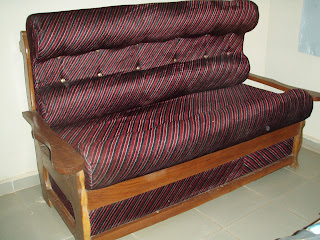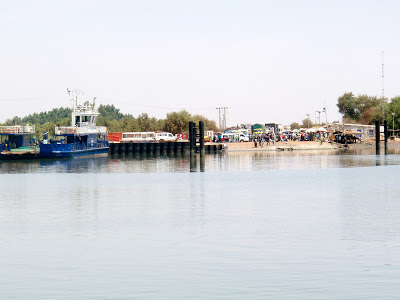Gambian furniture is not exactly what you will see in the United States. First of all it is hand-crafted (unless you purchase from one of the expensive furniture stores) I have already talked about my bed buying experience. But just the furniture itself is pretty interesting. The scale of most of it is quite large. Then it is made with the same foam that is in my mattress which makes sitting on it a heat inducing experience. Some of the design is down right confusing -- how can it be considered comfortable to have a big bump where your head should go and a big bump where your knees bend. I have seen this "feature" in more than one place and have included an illustration below:
I recently stayed in the "governor's residence" in one of the regions. There are six regions in the country with a governor of each region. However the governor's residence is not where the governor lives. It is a guest residence. They did say it is where President Jammeh would stay if he came to this region's headquarters. I figured I would include the pictures of I took there as examples of furniture. This was the bed in my room. Including mirrors in the hed boards is rather common. All of them have rather ornate carvings even if they don't have a mirror.
Adjoining my room was a common area for the two bedrooms that make up the top floor of the residence. Here is a chair -- to me it looks like the chair is angry.
This is the matching loveseat. There was actually an even bigger sofa but I could not get it all in the picture. You will note that there is carpeting on the floor. This is not really a good idea here with all of the sandy, dusty dirt that is everywhere.
The furniture is definitely hand made. There are no furniture assembly plants in The Gambia. This is the style that sells and you can see many of examples of it for sale alongside the road. I won't be bringing any of it home as a souvenir.
Wednesday, May 29, 2013
Baboons and crocodiles
I know my posts have slowed down. Part of the delay is that I have been fighting with Bank of America online. My advice is don't live in a third world country and try to communicate with BofA. They are totally and completely inflexible. ARGH! On the more pleasant side, I have also been plannng my vacation -- woohoo! I will be going to Tanzania to take a safari and then going to Zanzibar for 3 days of beach life. Of course all my Zanzibar relaxation will be cancelled out by the fact that it is taking me 3 days to get to Tanzania and 3 days to get back. Gambia is not what you would call a transportation hub.
Folks, I can now say that I live in Africa. I have had 3 "wild animal" experiences in one week. For the first I was walking on a different route to the United Nations when a very large monkey went scampering across the road and climbed a tree on the other side, but alas I did not have my camera with me. My next Africa moment was in the bush on a trek when a baboon ran across the road. I was excited by that and then the next thing I knew we saw a whole tree full of baboons. I asked the driver to stop so I could take a picture. He stopped but told me they would all run away when we stopped and he was right -- no pictures of a tree full of baboons. :-( Finally when I got back from trek I went with a friend for lunch at a restaurant that adjoined a fresh water pond. Next to the pond was with a sign with picture of a crocodile on it (sort of a "beware of the crocodile" sign with no words). We did not notice any crocodile action while we were eating, but after lunch we we walked around the pond to see if we can catch a sighting and voila there he was. He looked like a small log , but the log would go underwater and re-appear at another spot in the pond. I tried to get a picture of him but he was too fast for me.
I have mentioned ghellies before. They are the most common form of transport in the Gambia. Taxis are ubiquitous in the city but once you get out of the city, ghellies rule. I was in Farafenni eating breakfast, when I noticed a ghellie driver loading his vehicle. When he took a live goat and proceeded to tie it on the top of the vehicle I figured it warranted a picture. The animal was tied with a rope to the rack but otherwise was free. I hoped that he was sure-footed. I have also talked to Peace Corps volunteers who were in a ghelly when a goat on top of the vehicle peed -- not a pleasant experience.
I addition to a goat I also saw a bed loaded on a ghelly. (picture below) I also saw one ghelly with six people on the top but it was in the bush. Apparently it is illegal to ride on top but there is not much in the way of law enforcement in the bush. I did not get a picture of that because my camera was out of batteries at that point. I keep waiting to get a picture of a truckload of people. The army moves people in the back of big trucks, sometimes packed like sardines, but since they are on a moving vehicle there is not time to get my camera out and snap the picture. I have also seen people loaded into the back of pick up trucks, which is apparently legal because I see it frequently.
I had a kinda, sorta Con-way experience today. I attended a meeting of WFP logistics and programme staff with the transporters who deliver the school feeding food throughout the country. Since I just got back from a trek about three weeks ago in which I heard plenty from the consignee viewpoint, it was interesting to hear things from the transporters side of things. One of the things that I was shocked to hear was that they were not paid for over two months after they delivered the food.
One of the things that makes being a transporter interesting is the lack of bridges here. The lack of them is understandable because The Gambia River is pretty big and bridges are not cheap. Ferries are used and the lines for trucks getting on the ferry are incredible. On trek in a WFP vehicle we are given priority (thank goodness) and the trucks delivering the WFP food are supposed to be given priority but only on some days. The ferries in the main crossing between the north bank and the south bank at Banjul have been deemed unsafe by both the UN and the Peace Corps. Some of them have floated out into the ocean and been stuck for hours. I have not partaken of that ferry. I did go on a smaller ferry that is up country at a fairly narrow part of the river. My pictures are below. One of the interesting things was seeing trucks loaded with firewood and charcoal on the ferry headed north to Senegal. Deforestation is an issue here but money talks so people are cutting trees in the bush in The Gambia to sell in Senegal. Stopping to pickup charcoal at the end of trek is also routine because prices are cheaper up country than they are in Kombo. Here I am on the ferry as we are coming into one side. No, I have not gained a ton of weight. This shirt just makes me look like a porker.
There are two ferries. In the picture below the other one is loading on the left as we are arriving on the right. It gave me a warm fuzzy feeling to see a pump pumping out water from ferry the whole time that we were crossing. (not)
There are two ferries. In the picture below the other one is loading on the left as we are arriving on the right. It gave me a warm fuzzy feeling to see a pump pumping out water from ferry the whole time that we were crossing. (not)
Here is the wood and charcoal (in bags) going to Senegal. They get the trucks parked pretty closely as you can see.
Hope all is well in the USA. Keep reading the horrible news stories that pop up about shooters going in and killing people. What about gun control is a bad thing? There is no way that I can explain that to Gambians. I can't explain it to myself.
Subscribe to:
Posts (Atom)








